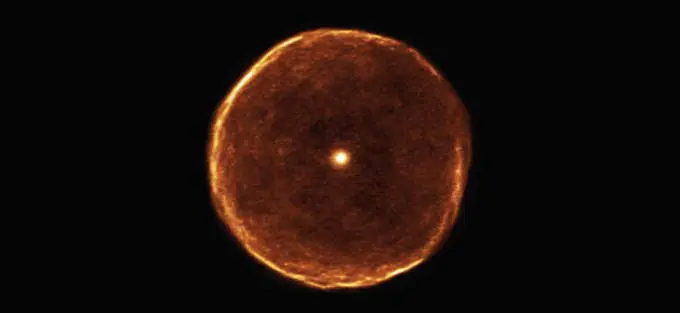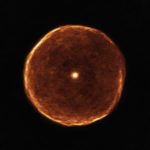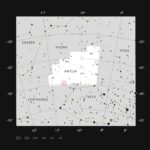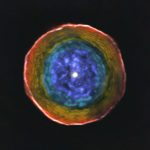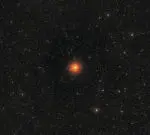Ageing Star Blows Off Smoky Bubble
Astronomers have used ALMA to capture a strikingly beautiful view of a delicate bubble of expelled material around the exotic red star U Antliae. These observations will help astronomers to better understand how stars evolve during the later stages of their life-cycles.
In the faint southern constellation of Antlia (The Air Pump) the careful observer with binoculars will spot a very red star, which varies slightly in brightness from week to week. This very unusual star is called U Antliae and new observations with the Atacama Large Millimeter/submillimeter Array (ALMA) are revealing a remarkably thin spherical shell around it.
U Antliae [1] is a carbon star, an evolved, cool and luminous star of the asymptotic giant branch type. Around 2700 years ago, U Antliae went through a short period of rapid mass loss. During this period of only a few hundred years, the material making up the shell seen in the new ALMA data was ejected at high speed. Examination of this shell in further detail also shows some evidence of thin, wispy gas clouds known as filamentary substructures.
This spectacular view was only made possible by the unique ability to create sharp images at multiple wavelengths that is provided by the ALMA radio telescope, located on the Chajnantor Plateau in Chile’s Atacama Desert. ALMA can see much finer structure in the U Antliae shell than has previously been possible.
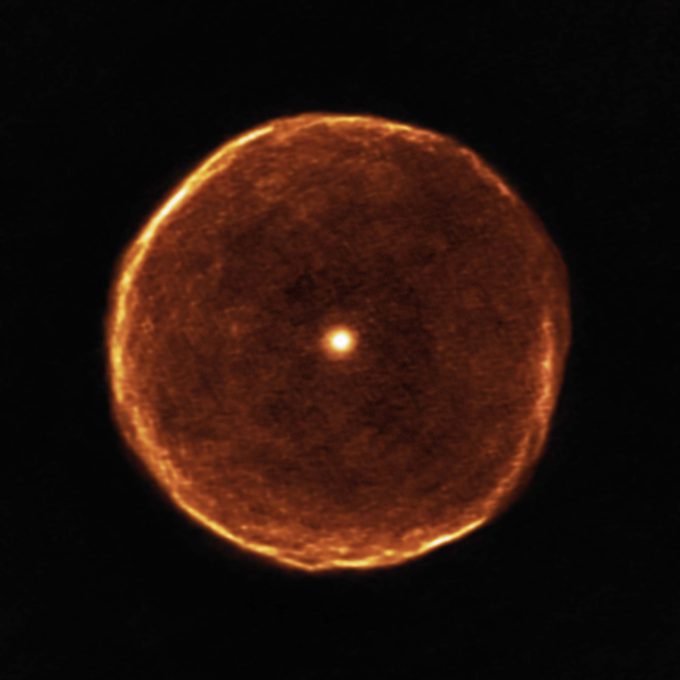
This ALMA image reveals much finer structure in the U Antliae shell than has previously been possible. Around 2700 years ago, U Antliae went through a short period of rapid mass loss. During this period of only a few hundred years, the material making up the shell seen in the new ALMA data was ejected at high speed. Examination of this shell in further detail also shows some evidence of thin, wispy clouds known as filamentary substructures. Credit: ALMA (ESO/NAOJ/NRAO)/F. Kerschbaum
The new ALMA data are not just a single image; ALMA produces a three-dimensional dataset (a data cube) with each slice being observed at a slightly different wavelength. Because of the Doppler Effect, this means that different slices of the data cube show images of gas moving at different speeds towards or away from the observer. This shell is also remarkable as it is very symmetrically round and also remarkably thin. By displaying the different velocities we can cut this cosmic bubble into virtual slices just as we do in computer tomography of a human body.
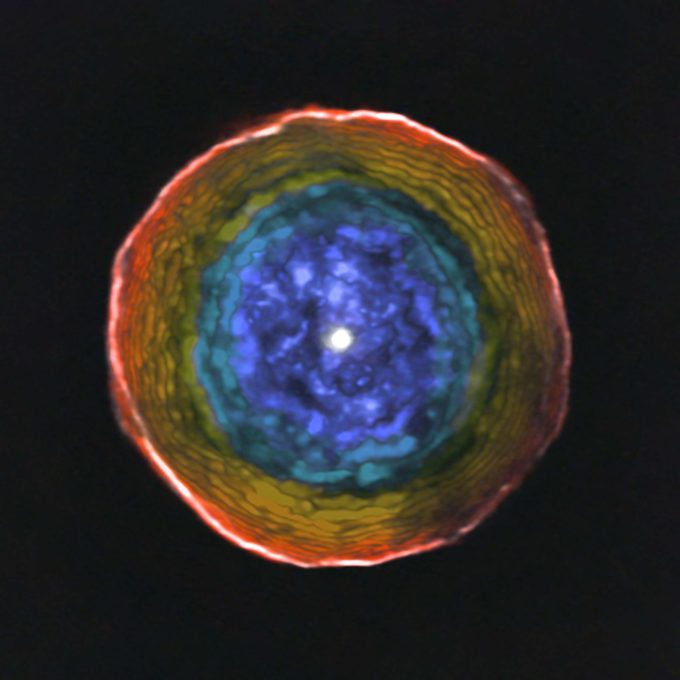
This image was created from ALMA data on the unusual red carbon star U Antliae and its surrounding shell of material. The colours show the motion of the glowing material in the shell along the line of sight to the Earth. Blue material lies between us and the central star, and is moving towards us. Red material around the edge is moving away from the star, but not towards the Earth. For clarity this view does not include the material on the far side of the star, which is receding from us in a symmetrical manner. Credit: ALMA (ESO/NAOJ/NRAO); F. Kerschbaum.
Understanding the chemical composition of the shells and atmospheres of these stars, and how these shells form by mass loss, is important to properly understand how stars evolve in the early Universe and also how galaxies evolved. Shells such as the one around U Antliae show a rich variety of chemical compounds based on carbon and other elements. They also help to recycle matter, and contribute up to 70% of the dust between stars.
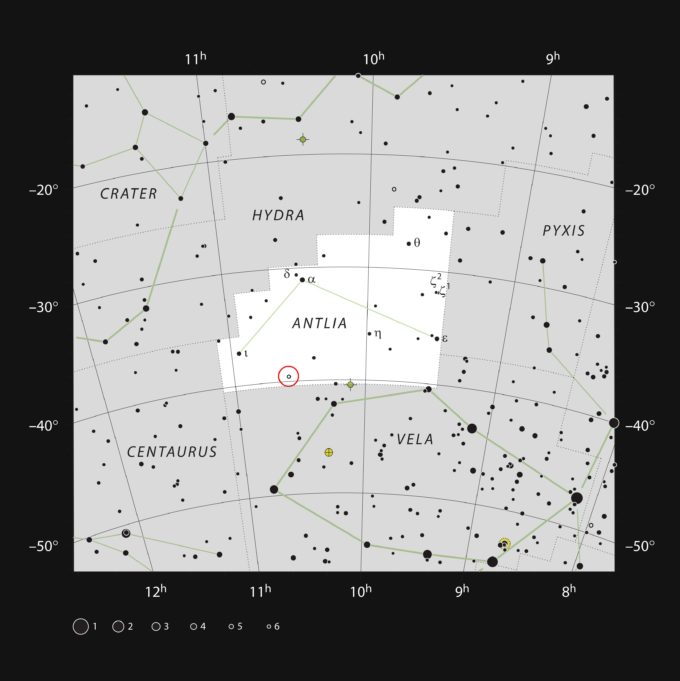
This chart shows the location of the star U Antliae in the constellation of Antlia (The Air Pump). This very red and variable star can be seen with small binoculars. Credit: ESO, IAU and Sky & Telescope.
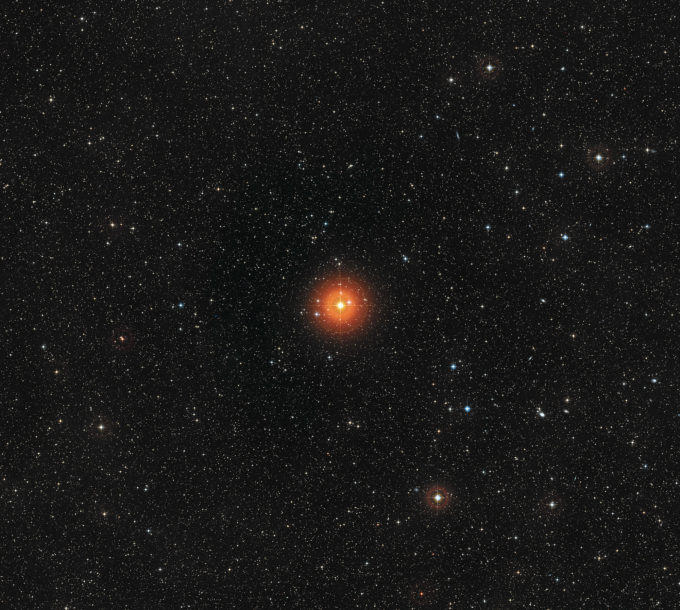
This image from the Digitized Sky Survey 2 shows the very red carbon star U Antliae and its surroundings. Credit: ESO, Digitized Sky Survey 2. Acknowledgement: Davide De Martin
Notes
[1] The name U Antliae reflects the fact that it is the fourth star that changes its brightness to be found in the constellation of Antlia (The Air Pump). The naming of such variable stars followed a complicated sequence as more and more were found and is explained here.
More information
This research was presented in a paper entitled “Rings and filaments. The remarkable detached CO shell of U Antliae”, by F. Kerschbaum et al., to appear in the journal Astronomy & Astrophysics.
The team is composed of F. Kerschbaum (University of Vienna, Austria), M. Maercker (Chalmers University of Technology, Onsala Space Observatory, Sweden), M. Brunner (University of Vienna, Austria), M. Lindqvist (Chalmers University of Technology, Onsala Space Observatory, Sweden), H. Olofsson (Chalmers University of Technology, Onsala Space Observatory, Sweden), M. Mecina (University of Vienna, Austria), E. De Beck (Chalmers University of Technology, Onsala Space Observatory, Sweden), M. A. T. Groenewegen (Koninklijke Sterrenwacht van België, Belgium), E. Lagadec (Observatoire de la Côte d’Azur, CNRS, France), S. Mohamed (University of Cape Town, South Africa), C. Paladini (Université Libre de Bruxelles, Belgium), S. Ramstedt (Uppsala University, Sweden), W. H. T. Vlemmings (Chalmers University of Technology, Onsala Space Observatory, Sweden), and M. Wittkowski (ESO)
The Atacama Large Millimeter/submillimeter Array (ALMA), an international astronomy facility, is a partnership of ESO, the U.S. National Science Foundation (NSF) and the National Institutes of Natural Sciences (NINS) of Japan in cooperation with the Republic of Chile. ALMA is funded by ESO on behalf of its Member States, by NSF in cooperation with the National Research Council of Canada (NRC) and the National Science Council of Taiwan (NSC) and by NINS in cooperation with the Academia Sinica (AS) in Taiwan and the Korea Astronomy and Space Science Institute (KASI).
ALMA construction and operations are led by ESO on behalf of its Member States; by the National Radio Astronomy Observatory (NRAO), managed by Associated Universities, Inc. (AUI), on behalf of North America; and by the National Astronomical Observatory of Japan (NAOJ) on behalf of East Asia. The Joint ALMA Observatory (JAO) provides the unified leadership and management of the construction, commissioning and operation of ALMA.
Contacts
-
Nicolás Lira
Education and Public Outreach OfficerJoint ALMA Observatory, Santiago - ChilePhone: +56 2 2467 6519Cel: +56 9 9445 7726Email: [email protected] -
Richard Hook
Public Information Officer, ESOGarching bei München, GermanyPhone: +49 89 3200 6655Cel: +49 151 1537 3591Email: [email protected] -
Francisco Rodríguez I.
ESO Press Officer in Chile -
Charles E. Blue
Public Information OfficerNational Radio Astronomy Observatory Charlottesville, Virginia - USAPhone: +1 434 296 0314Cel: +1 202 236 6324Email: [email protected] -
Masaaki Hiramatsu
Education and Public Outreach Officer, NAOJ Chile
